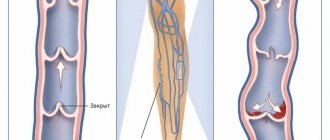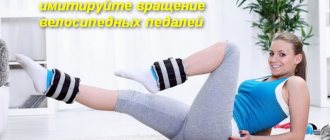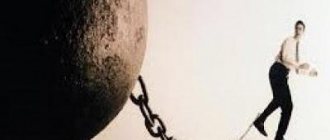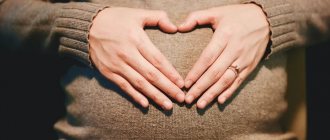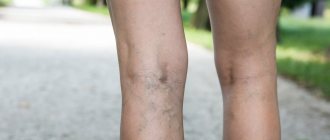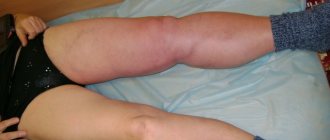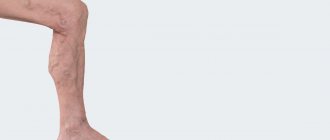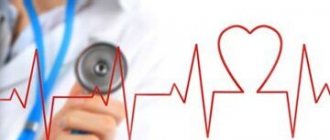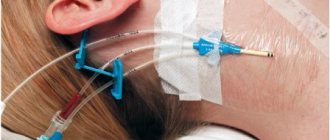Gymnastics for varicose veins is an effective method of preventing and treating the disease. It is also prescribed as a rehabilitation measure after surgical and medicinal correction.
Suitable exercises relieve fatigue and swelling in the legs, and significantly improve the appearance of the lower extremities. If you ignore the first manifestations of varicose veins, you may encounter serious problems such as protruding veins, seals and even trophic ulcers. It is extremely important to do gymnastics regularly - it does not take much time.
Reasons for the development of varicose veins
Varicose veins are a pathology that develops gradually. The etiology of the disease in each case is individual: genetic predisposition, sedentary lifestyle, unhealthy diet, wearing tight shoes, obesity, pregnancy, etc. The blood supply to the lower extremities is disrupted, as a result of which the walls of blood vessels are damaged. The first signs that you are developing varicose veins and it’s time to do leg exercises are:
- Discomfort in the legs. Many people attribute it to fatigue and put off going to the doctor until the veins begin to bulge strongly;
- Painful sensations after being in a static position;
- Feeling of burning, heaviness, itching in the area of visible veins;
- Swelling of the lower extremities in the evening;
- Vessels become visible on the legs - red, purple, blue;
- The skin on the lower legs darkens;
- The veins swell and become significantly larger, protruding above the skin.
If one or more symptoms appear, it is recommended to contact a phlebologist as soon as possible. If this is not possible at the moment, therapeutic exercises are the best solution to the problem.
Varicose veins and fitness in Moscow. Prevention of varicose veins.
So what should you do if your legs become heavy and swollen in the evening, and then spider veins and varicose veins begin to appear on them? First of all, you should change your lifestyle to avoid congestion in the legs. If the work is sedentary, you should find a way to move whenever possible and change your position as often as possible, at least shifting from foot to foot. It’s better to forget about thermal procedures and shapewear, but you don’t need to give up heels. The main thing is to choose shoes that are comfortable and flexible, especially in the toes, and of course, do not wear heels all day. Orthopedists advise changing shoes as often as possible and walking barefoot whenever possible.
Special compression stockings or stockings from a good, trusted manufacturer also have a beneficial effect on varicose veins.
Fitness and prevention of varicose veins
The habit of resting while sitting or lying down with your legs elevated 30° has a beneficial effect on the veins (the common recommendation to “throw your legs over the wall” is not very useful for the retroperitoneal veins). A good diet will also come in handy. Foods such as legumes, wheat germ, nuts, rose hips strengthen the walls of blood vessels, and a phlebologist will help you choose effective medications for internal and external use.
The benefits of physical therapy
Regularly performing simple physical exercises will help:
- improve venous and lymphatic drainage;
- normalize arterial blood flow;
- restore the patency of the vascular bed in the damaged area;
- significantly reduce dystrophic changes in the tissues of the lower extremities;
- relieve heaviness in the legs, relieve swelling.
Also, exercise will help normalize skin tone, restore its healthy color, and stimulate regenerative processes in the deep layers of the epidermis.
Sources
- Simm PJ., Munns CF., Jefferies CA., Wheeler BJ. Editorial: Childhood Rickets—New Developments in Epidemiology, Prevention, and Treatment. // Front Endocrinol (Lausanne) - 2021 - Vol11 - NNULL - p.621734; PMID:33329409
- Fukumoto S. FGF23-related hypophosphatemic rickets/osteomalacia: diagnosis and new treatment. // J Mol Endocrinol - 2021 - Vol66 - N2 - p.R57-R65; PMID:33295878
- Liu C., Li X., Zhao Z., Chi Y., Cui L., Zhang Q., Ping F., Chai X., Jiang Y., Wang O., Li M., Xing X., Xia W. Iron deficiency plays essential roles in the trigger, treatment, and prognosis of autosomal dominant hypophosphatemic rickets. // Osteoporos Int - 2021 - Vol32 - N4 - p.737-745; PMID:32995940
- Makrygiannakis M., Dastoori M., Athanasiou A.E. Orthodontic treatment of a nine-year-old patient with hypophosphatemic rickets diagnosed since the age of two: A case report. // Int Orthod - 2020 - Vol18 - N3 - p.648-656; PMID:32771307
- Colazo JM., Reasoner SA., Holt G., Faugere MCM., Dahir KM. Hereditary Hypophosphatemic Rickets with Hypercalciuria (HHRH) Presenting with Genu Valgum Deformity: Treatment with Phosphate Supplementation and Surgical Correction. // Case Rep Endocrinol - 2020 - Vol2020 - NNULL - p.1047327; PMID:32695531
- Sura SR., Germain-Lee EL. Treatment of rickets and dyslipidemia in twins with progressive familial intrahepatic cholestasis type 2. // Int J Pediatr Endocrinol - 2021 - Vol2020 - NNULL - p.9; PMID:32508937
- Grover M., Maahs DM. 50 Years Ago in The Journal of Pediatrics: Advances in Diagnosis and Treatment of Pseudovitamin D Deficiency Rickets. // J Pediatr - 2021 - Vol221 - NNULL - p.200; PMID:32446481
- Chibuzor MT., Graham-Kalio D., Osaji JO., Meremikwu MM. Vitamin D, calcium or a combination of vitamin D and calcium for the treatment of nutritional rickets in children. // Cochrane Database Syst Rev - 2021 - Vol4 - NNULL - p.CD012581; PMID:32303107
- El-Sobky TA., Samir S., Baraka MM., Fayyad TA., Mahran MA., Aly AS., Amen J., Mahmoud S. Growth Modulation for Knee Coronal Plane Deformities in Children With Nutritional Rickets: A Prospective Series With Treatment Algorithm. // J Am Acad Orthop Surg Glob Res Rev - 2021 - Vol4 - N1 - p.; PMID:32159063
- Godfrey EK., Mussa F., Kazahura P., Shoo A., Naburi H., Manji KP. Vitamin D-Resistant Rickets Diagnostics and Treatment Challenges at Muhimbili National Hospital, Tanzania. // Case Rep Endocrinol - 2021 - Vol2020 - NNULL - p.1547170; PMID:32082647
Gymnastics for treatment
If you have been diagnosed with varicose veins, therapeutic exercises should become an integral part of your life. Here the exercises will be more difficult than in the case of preventive exercises. However, they must be performed if you want to consolidate the results of drug therapy and prevent the development of serious complications.
Physical exercise
- Lie on your back, lift your right leg up, and reach for it with your left hand. Then repeat the exercise with your left leg and right arm. The optimal load is 10-15 repetitions (look at your own feelings, if it’s hard, don’t overload the body).
- Lying on your back, bend your knees and press them to your stomach. In this position, raise your head and body, reaching towards your legs. Hold this pose for a few seconds, then relax and rest for 15-20 seconds.
- While lying down, lift your legs vertically and rotate your feet. Spend 5-7 minutes on this exercise.
- Sit on a chair. Place your arms behind the back of the chair, lift your legs with your knees bent, then straighten them horizontally. Bend your legs again and slowly lower. Do 5-10 approaches.
- Stand on a solid surface and begin to actively march. Bend your knees and try to lift them as high as possible.
- Finally, do one more simple exercise. Lie down, tense your legs and pull your toes as hard as possible so that you feel tension in your calf muscle. You need to do 5-10 approaches of 10 seconds.
No equipment or special devices are needed for classes. It is important that the surface on which you lie down is flat and moderately hard - you can lay a fitness mat or a regular blanket. The main thing is that the exercises do not bring discomfort or pain.
Breathing exercises
They are performed in conjunction with physical ones. You need to breathe deeply, measuredly. You should also alternate between diaphragmatic and chest breathing:
- Breathe deeply for a minute and gradually exhale. So that the chest rises.
- Then change tactics - breathe with your stomach connected. As you inhale, it should increase, and as you exit, it should decrease.
This will improve charging efficiency and saturate the tissues with oxygen.
Walking
Regular walking is the key to healthy feet. There is no need to go to extremes and walk everywhere exclusively. 30-60 minutes of leisurely walking a day will perfectly help cope with the signs of varicose veins.
Complex exercises
It is not at all necessary to perform all of the above exercises. Create the most optimal complex for yourself and spend 20-30 minutes a day on exercises. In addition to preventing varicose veins, exercise will help strengthen the leg muscles and tighten the skin.
Exercises for prevention
Prevention of varicose veins of the lower extremities consists of dosed, complex loads. An excellent method to prevent the development of the disease is swimming.
Here is a list of the most common exercises for the prevention of varicose veins, which are easy to perform at home:
- Sitting. Stretch your legs forward, perform circular movements with your feet clockwise and counterclockwise, repeat 10-15 times. Then place one foot on the toe, the other on the heel, alternate the position 10-15 times.
- Standing. Carefully rise to your toes, gradually lower to your heels, also 10-15 times. Then spread your legs shoulder-width apart and repeat the exercise. You can do 5-10 smooth squats.
- Lying down. A popular exercise is cycling - repeat the movements for 30-40 seconds. Then stretch your legs up, pointing your toes towards the ceiling. Keep your legs straight, slowly open and close them, 10-15 repetitions.
Additional recommendations
Even if you regularly perform physical exercises for varicose veins, do not expect an immediate effect. To eliminate the symptoms of the disease, you must also follow the following recommendations:
- Wear compression stockings. It significantly reduces pressure on the walls of blood vessels, relieves swelling and the feeling of fullness. However, you should use medical knitwear only according to a doctor’s indications - amateur efforts in this matter can lead to aggravation of the situation.
- Avoid being near a hot battery or open fire. Elevated temperatures interfere with normal blood circulation.
- Avoid eating excessively salty foods. If you have varicose veins, you should completely avoid table salt - it retains water in the body and interferes with normal fluid circulation.
- Take baths in the morning, not before bed. If possible, it is better to limit yourself to a shower.
- Watch your weight. In obese people, the load on all body systems, primarily the cardiovascular system, is significantly increased.
- Sleep - exclusively lying down. If you decide to take a nap on a sofa or chair, place your legs horizontally. Prolonged stay of the lower extremities in a vertical position significantly increases the load on the vascular bed.
In the treatment of varicose veins, an integrated approach is extremely important. Even surgery, sclerotherapy and other modern techniques will not give lasting results if the doctor’s recommendations are not followed.
Exercises strictly contraindicated for varicose veins
There are a number of activities that can negate the entire positive effect of exercises for the treatment of varicose veins:
- Strength exercises with a barbell. To perform them, the body needs a huge amount of energy and resources. When lifting a barbell while standing, there is a possibility of permanently destroying the veins in your legs.
- Squats with weights. They lead to stagnation of blood in the legs and enormous pressure on the vascular bed of the lower extremities.
- Exercise bike. Absolutely not suitable for people with varicose veins.
- Jumping. When landing, bones, joints and soft tissues absorb the jump, and the lion's share of the load goes to the veins and blood vessels.
- Run. Even the most advanced treatment techniques will not help if you run regularly, especially on hard surfaces.
All of the above exercises only worsen varicose veins on the legs. They provoke blood stagnation, lead to a decrease in the elasticity of the veins, and significantly increase the risk of blood clots.
Exercises for varicose veins should only be prescribed by a specialized specialist. This could be a phlebologist with whom you are seeing, or an experienced rehabilitation therapist who cares for patients with problems of the cardiovascular system.
Still have questions about exercises for varicose veins?
Free consultation with AngioClinic specialists
Author
Salmina Daria Vladimirovna
Geneticist. Graduated from the Chelyabinsk State Medical Academy. She completed an internship at the Northwestern State Medical University named after I.I. Mechnikov.
Varicose veins and fitness. Fitness as a prevention of varicose veins
Although varicose veins are considered an occupational disease of dancers, moderate dancing will help keep muscles and blood vessels toned. Strip plastic and Latin American dancing will be useful, for which you need to choose the most comfortable shoes with medium heels, and, if necessary, also compression socks or stockings (warming up leg warmers should be strictly avoided). Oriental dances provide the most gentle and at the same time effective load on the legs.
Oriental dancing and varicose veins
In any case, it is better to engage in this kind of active activity after consulting a competent phlebologist with mandatory ultrasound scanning. This is the leading condition and the best solution for a good start in sports or fitness. Also, this simple and not too financially expensive step is today available to the vast majority of Russians, and not just to residents of Moscow and the Moscow region. Today everyone can afford to diagnose varicose veins according to the best European standards. The importance of a good innovative assessment of the condition of the venous bed cannot be overestimated. Modern medical statistics on the prevalence of varicose veins speak of sad figures. Not a single resident of a metropolis such as Moscow can be immune from this pathology.
Simple rules of behavior and nutrition help not only stop the development of unpleasant symptoms of a common disease, but also restore the elasticity of blood vessels and enjoy an active lifestyle. Moreover, this is available to the majority of residents of Moscow and the Moscow region, as well as other cities and regions of Russia.
Innovative techniques used in modern medicine do not replace physiological physical activity. It is necessary to remember this. Movement is life, a classic, relevant in a modern metropolis such as Moscow.
